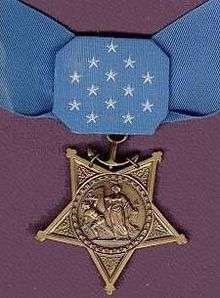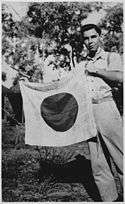Ernest E. Evans
| Ernest Edwin Evans | |
|---|---|
 LCdr. Ernest E. Evans at the commissioning ceremonies of USS Johnston, Seattle, Washington, October 27, 1943. | |
| Born |
August 13, 1908 Pawnee, Oklahoma |
| Died | October 25, 1944 (aged 36) |
| Allegiance |
|
| Service/branch |
|
| Years of service | 1931–1944 |
| Rank |
|
| Commands held |
USS Alden USS Johnston |
| Battles/wars |
World War II *Battle off Samar |
| Awards |
Medal of Honor Navy Cross Bronze Star Purple Heart American Defense Medal Asiatic-Pacific Campaign Medal World War II Victory Medal Philippine Liberation Medal |
Ernest Edwin Evans (August 13, 1908 – October 25, 1944) was an officer of the United States Navy who posthumously received the Medal of Honor for his actions during the Battle off Samar in World War II.
Biography
Evans, of Native American ancestry (half Cherokee and one quarter Creek), was born in Pawnee, Oklahoma. He graduated from the United States Naval Academy in 1931.
On 9 August 1941, he was assigned to the destroyer Alden, and was serving on her in the East Indies when the Japanese attacked Pearl Harbor on December 7 of that year. He became commanding officer of Alden on 14 March 1942, and held that position until 7 July 1943. While serving on Alden he participated in operations in and around Australia, New Guinea and the Dutch East Indies.
In mid-1943 Evans was then ordered to duty in charge of fitting out the Fletcher-class destroyer Johnston at the Seattle-Tacoma Shipbuilding Corporation in Seattle, Washington. Commander Evans assumed command of Johnston at her commissioning on 27 October 1943. He was awarded the Bronze Star for meritorious achievement in action against a Japanese submarine on May 16, 1944.
Battle off Samar
In the Battle off Samar, a part of the Battle of Leyte Gulf, Evans fought his ship gallantly until it was sunk on October 25, 1944, by a Japanese force that was vastly superior in number, firepower, and armor. Johnston, together with the destroyers Hoel and Heermann, four destroyer escorts and six escort carriers (CVEs) formed the task unit 77.4.3, known as Taffy 3. This group, together with planes from Taffy 2 (TU 77.4.2), ultimately forced a Japanese battlegroup consisting of several battleships, heavy cruisers, light cruisers and destroyers to abort its original mission to attack the landing beaches at Leyte under the command of General Douglas MacArthur and retreat.
When the Japanese fleet during the Battle off Samar was first sighted, Evans did not hesitate. He ordered his helm sharp to port and he led his destroyer out of the task unit's circular antiaircraft disposition in favor of charging the enemy alone to make a torpedo attack. Some claim that Evans told his crew over the ship's intercom: "A large Japanese fleet has been contacted. They are fifteen miles away and headed in our direction. They are believed to have four battleships, eight cruisers, and a number of destroyers. This will be a fight against overwhelming odds from which survival cannot be expected. We will do what damage we can." However, contemporaneous sources credit the latter part of this dramatic announcement to LCDR Robert W. Copeland of the Samuel B. Roberts, who charged in with Evans on a subsequent torpedo run.[1]
The fate of the Johnston's captain was never conclusively established, and remains the subject of continuing conjecture among the ship's survivors. Some claim that he was hit by Japanese naval shellfire; others that he was able to jump into a damaged motor whaleboat. What is known is that he was seriously wounded during the battle; that he lived long enough to give the abandon ship order; and that he was not among those rescued. Evans was posthumously awarded the Medal of Honor for his material contribution to the decisive victory won in Leyte Gulf and shared in the Presidential Unit Citation awarded his group for this action in which he gave his life.
Namesake
In 1955, the destroyer escort USS Evans (DE-1023) was named in his honor.[2] It was decommissioned in 1968, and no active ship carries the name of Evans or Johnston, although a number of active ships have been named for Samuel B. Roberts and her crew. On November 12, 2013, a petition was created to name a ship after Evans.[3]
On May 23, 2013, the Naval Station Newport, Newport, Rhode Island, Surface Warfare Officers School's virtual simulator for shiphandling training was dedicated as the Evans Full Mission-2 Simulator in Evans' honor.[4]
Awards
Medal of Honor citation

For conspicuous gallantry and intrepidity at the risk of his life above and beyond the call of duty as commanding officer of the U.S.S. Johnston in action against major units of the enemy Japanese fleet during the battle off Samar on 25 October 1944. The first to lay a smokescreen and to open fire as an enemy task force, vastly superior in number, firepower and armor, rapidly approached. Comdr. Evans gallantly diverted the powerful blasts of hostile guns from the lightly armed and armored carriers under his protection, launching the first torpedo attack when the Johnston came under straddling Japanese shellfire. Undaunted by damage sustained under the terrific volume of fire, he unhesitatingly joined others of his group to provide fire support during subsequent torpedo attacks against the Japanese and, outshooting and outmaneuvering the enemy as he consistently interposed his vessel between the hostile fleet units and our carriers despite the crippling loss of engine power and communications with steering aft, shifted command to the fantail, shouted steering orders through an open hatch to men turning the rudder by hand and battled furiously until the Johnston, burning and shuddering from a mortal blow, lay dead in the water after 3 hours of fierce combat. Seriously wounded early in the engagement, Comdr. Evans, by his indomitable courage and brilliant professional skill, aided materially in turning back the enemy during a critical phase of the action. His valiant fighting spirit throughout this historic battle will venture as an inspiration to all who served with him.
See also
Notes
- ↑ According to the action report of the USS Samuel B. Roberts (DE-413), "The crew were informed over the loud speaker system at the beginning of the action, of the Commanding Officer's estimate of the situation, that is, a fight against overwhelming odds from which survival could not be expected, during which time we would do what damage we could. In the face of this knowledge the men zealously manned their stations wherever they might be, and fought and worked with such calmness, courage and efficiency that no higher honor could be conceived than to command such a group of men." USS Samuel B. Roberts (DE-413), "Combined Action Report, Surface Engagement off Samar, Philippine Islands, and Report of Loss of USS Samuel B. Roberts (DE-413), on 25 October 1944," November 20, 1944, Serial X001, page 14.
- ↑
- "history.navy.mil: USS Evans". Retrieved September 29, 2010.
- ↑ http://wh.gov/lBqUJ. Retrieved November 12, 2013. Missing or empty
|title=(help) - ↑ Edward A. Sherman Publishing Co. (7 June 2013). "SWOS simulator renamed after heroic destroyerman". Newport Navalog. p. 9.
References
- Cox, Robert Jon (2010). The Battle Off Samar: Taffy III at Leyte Gulf (5th Edition). Agogeebic Press, LLC. ISBN 0-9822390-4-1.
- James D. Hornfischer, The Last Stand of the Tin Can Sailors, Bantam Books, 2004. ISBN 0-553-80257-7
- Evan Thomas, Sea of Thunder: Four Commanders and the Last Great Naval Campaign 1941–1945, Simon & Schuster, 2006. ISBN 0-7432-5221-7
Audio/visual media
- Lost Evidence of the Pacific: The Battle of Leyte Gulf. History Channel. TV. No writer given.
- Dogfights: Death of the Japanese Navy. History Channel. TV. No writer given.
External links
- "history.navy.mil: USS Evans". Retrieved September 29, 2010.
- "Ernest E. Evans". Claim to Fame: Medal of Honor recipients. Find a Grave. Retrieved 2007-10-28.
- "The Battle Off Samar – Taffy III at Leyte Gulf by Robert Jon Cox". Retrieved September 29, 2010.
- "Designate a future Arleigh-Burke class destroyer to be named USS Evans for Medal of Honor recipient Ernest E. Evans.". Archived from the original on November 12, 2013. Retrieved November 12, 2013.
- This article incorporates text from the public domain Dictionary of American Naval Fighting Ships.
